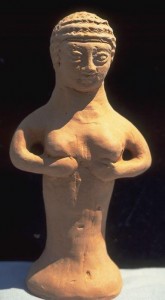For those of you familiar with our Christmas Adam tradition, you will recall that in the last few years I’ve included a section on Wisdom (Asherah). With the subsequent interpretation as our Mother in Heaven.
I’ve attached a small excerpt from a review of Dr. Barker’s book for your reading pleasure.
Barker’s Thesis for The Mother of the Lord
The Mother of the Lord builds on themes from Barker’s previous work in The Great High Priest (2003) and Temple Theology (2004).1 Her thesis for this volume is that worship in the first temple venerated not a monotheistic supreme Creator God, but a Family of divine beings within an even larger Council of Gods. This Family consisted of the Father, called the Highest; the Mother, identified with the consort-Goddess Asherah and known as the personification of Wisdom; and the Son, who was named the Lord. She presents arguments to show how the Son and Father were collapsed and convoluted into the One God of the Hebrew Bible we read now, and Wisdom the Mother was banished entirely, surviving only in clues and fragments.
According to Barker, Abraham’s earliest version of temple worship was deliberately changed, “purified” by King Josiah in the sixth century bce, to align with The Book of the Law. This book, which was discovered as the temple was renovated, is arguably either a version of Deuteronomy or an extracanonical law code. Its adherents, aligned with Josiah’s reform efforts or he with theirs, are referred to as the Deuteronomists. Their temple and worship overhaul caused the loss of what were likely many plain and precious things. Among these were the older ideas, symbols, possibly entire rituals, and forms of words from the temple as its adherents had known it, including the Lady Wisdom. At the time of the purge, Barker notes, groups of traditionalist believers (we may think of Lehi [Page 100]and his family) left or were driven from Jerusalem, and in their exile they continued the older forms of Abrahamic worship (Barker, 75).
As Wisdom, the goddess was the female element of divine nurturance, and when Old Testament prophets reference Wisdom, it is almost always a reference to her (Barker, 234). Without Wisdom, worshippers were left in the hands of the Law without consideration, without mercy or understanding (Barker, 364-65). She was the recognizable sign of God’s presence among the people, though her identity was obscured by her many manifestations; she was Wisdom, Khokhmah; she was the presence of God, Shekinah, Pillar and Shadow; her iconic symbols were indicative of her being the Mater-matter of life: the Breath of God; the Spirit; Holy Fire (she speaks to Moses from a burning, unconsumed fruit bush); fertile fields; high places (mountains or hills; the proto-temples of Abraham, Moses, etc.); the abundance and faithful generosity of fruit-bearing trees (including their derivatives, wooden totems); and the vessel that bears the Lord, sometimes represented as a dish or bowl but often symbolized as the Throne (see chapter 5).
